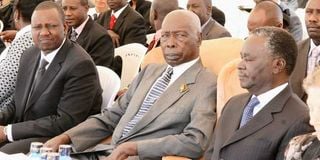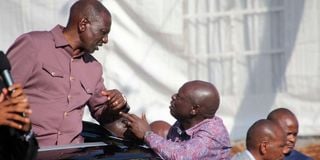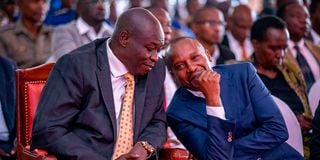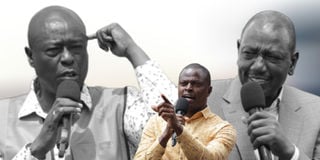
Former President Daniel arap Moi and Agriculture minister William Ruto (left) during a function on February 26, 2009.
When President Daniel arap Moi assumed office in 1978, one of his first major acts of power consolidation moves was to neutralise the powerful Gikuyu, Embu, Meru Association (Gema), which had reigned supreme as the regional power-base of the late President Jomo Kenyatta.
He declared a ban on all tribal organisations, in the stroke of a pen halting the political activities of the influential Mt Kenya ethnic bloc led by wealthy businessman-politician Njenga Karume, which had the potential to challenge his hold on power.

The late Njenga Karume.
The organisation’s commercial arm, Gema Holdings Ltd, was allowed to remain, but changed its name to Agricultural and Industrial Holdings Ltd.
The move on Gema with collateral damage as all other associations, including sports and cultural clubs built around an ethnic or communal base had to shut down or change their names. One of Kenya’s leading football clubs, Abaluhya FC, changed its name to Al Footballers Cooperative Leopards, retaining the AFC initials. Its major rival. Gor Mahia FC, changed name to Gulf Olympic Ranger, holding on to the Gor identity, but later earned a presidential reprieve on appeal from community leaders and reverted to the familiar name. Luo Union FC from the same community, became Reunion FC. Beyond soccer sporting, and social clubs form the Asian community also had to change their names. Sikh Union became Simba Union, Patel Club became Premier Club, Goan Gymkhana became Nairobi Gymkhana.
Moi’s next move was to neutralise the key Gema leaders who had surrounded the late Kenyatta and become a power unto themselves. To do that most effectively, he relied on key hatchet men from the same community such as his powerful Attorney-General Charles Njonjo and Interior minister GG Kariuki. It was a tactic he relied on in later years whenever he had to tame potential threats from Kenya’s populous communities—using their own people to fight them.

Daniel arap Moi (left) and Charles Mugane Njonjo.
Crushing halt
In the run-up to the 1988 elections while preparing ground for removal of then Vice President Mwai Kibaki, it was politicians from the VP’s Nyeri backyard such as Waruru Kanja, Davidson Kuguru and Ngumbu Njururi and others form further afield in the Mt Kenya region who were employed to lead the assault. The tactic was repeated against Kibaki’s successor as Vice President Josephat Karanja, whose short stint was brought to a crushing halt under the weight of an offensive driven by mid-ranking politicians from his own backyard such as Kuria Kanyingi and David Mwenje.
Moi also employed the same tactics to contain potential threats from opposition pioneer and Kenya’s first Vice President Jaramogi Oginga Odinga, by sponsoring alternative leaders from his Luo community such as Odongo Omamo, Okiki Amayo and Oloo Aringo. It was strategy that had also been used by Moi’s predecessor to tame Odinga.
History is repeating itself. On September 5 a majority of MPs from Deputy President Rigathi Gachagua’s Mt Kenya backyard issued the ‘Nyahururu Declaration’, in which they proclaimed recognition of Interior Cabinet Secretary Kithure Kindiki as their link to President William Ruto. They did not mention the DP neither by name or title, but what they were signalling is rejection of Gachagua ‘s presumed role as the seniormost Mt Kenya political leader.

President William Ruto chats with his deputy Rigathi Gachagua during the commissioning of Changachicha Irrigation project in Nyeri County on February 15, 2024.
This will be a big blow for the DP, who since the 2022 elections has fought hard to fill the big void left in Mt Kenya leadership after President Uhuru Kenyatta vacated office.
The move effectively cuts the feet off from under the DP, depicting a senior political leader with aspirations to higher national office, including the presidency, who is rejected by his own people. Assembling 48 MPs from the wider Mt Kenya, region, including those from his Nyeri backyard, to effectively reject the country’s second-in-command is no mean feat. Such a move would require high level of logistics, mobilisation and funding, and could only have been pulled with the and support of the President.
The Declaration came just three days after a crop of MPs from the Mt Kenya East sub-region, essentially the Meru and Embu, announced their ‘divorce’ from their Kikuyu cousins. They said they had always played second fiddle to the dominant community, voting for their presidential candidates since independence but getting no reciprocal. They announced that the now recognise Kindiki as their political supremo, a move that fits squarely into the kind of divide and rule strategies perfected by Moi.
But the move comes with several ironies. In the first instance, a group of Mt Kenya East MPs declare their ‘independence’ from the wider Mt Kenya political sphere, and install Kindiki as their kingpin. A few days later a larger grouping of Mt Kenya West MPs also install Kindiki as their kingpin, therefore restating the common Gema umbrella.
Also interesting is the rationale offered for the Nyahururu Declaration. The statement rued that Mt Kenya politics has since the Kenya Kwanza regime took office “suffered high octane politics …to support individual and personal ambition”, a reference to Gachagua’s unrealised quest be recinised as the region’s political kingpin; but in the same breath announce elevation of Kindiki to just that position.
What matters most, however, is that the DP who took office on the implicit understanding that he was the Mt Kenya political supremo in the Kenya Kwanza government and presumably first in line to succeed President Ruto has suffered what looks like a mortal blow.
Ever since it became public knowledge that he was falling out with President Ruto, Gachagua has worked hard to cement his position by moving aggressively to try and take control of the large Mt Kenya floating vote that ensured the duo victory at the 2022 presidential elections.
He has gone to the extent of trying to mend fences with Uhuru, even issuing public apologies to the man he mercilessly attacked during and after the campaigns.

Former President Uhuru Kenyatta addressing the press from his son's home in Karen, Nairobi, on Friday July 21.
Uhuru has never publicly responded to Gachagua’s overtures, and it has remained clear all along that efforts to establish himself as the region's political kingpin were not bearing much fruit.
In the meantime, the self-styled ‘truthful man’ has also been aiming veiled jabs at Ruto. Not too long before his foes teamed up to disown his presumed regional supremacy, the DP pointedly told a public forum that he could not promise them some requested development projects because he likes to speak the truth, and would not accede to their requests just to earn applause while not sure funds would be available. That was a barely disguised jab at Ruto, who has earned notoriety for delivering extravagant promises that are rarely fulfilled.
Remaining allies
Never one to take things lying down, Gachagua on Friday, September 13, responded hard to the MPs ganged up against him in Nyeri, terming them “traitors”. While he has clearly been isolated and outmanoeuvred, his few remaining allies in Mt Kenya making light of the assault, spinning the narrative that it was the DP, rather than the MPs, who had the support of the people. Former Nyeri Town MP Ngunjiri Wambugu took the view that the leaders behind the Nyahururu Declaration were in effect writing their own political obituaries as they would be punished by the voters come the next elections.
“All politics is local,” he told The Weekly Review, “You tell can’t tell Nyeri people that you’ve chosen someone from Tharaka (Kindiki) to be their leader, yet they have one of their own as the DP”.

Deputy President Rigathi Gachagua (left) confers with Interior Cabinet Secretary Kithure Kindiki in Nyeri town on April 14, 2023.
He was referring to Nyeri MPs who signed on to the anti-Gachagua declaration. The include his successor as the MP for Mathira Eric Wamumbi, as well as John Kaguchia (Mukurweini), Duncan Mathenge (Nyeri Town), (Geoffrey Wandeto (Tetu) Senator Wahome Wamatinga and County woman MP Rahab Mukami.
Wambugu said the MPs are already facing a severe backlash from Mt Kenya voters after having voted for the contentious Finance Bill 2024 against the wishes of their constituents, predicting that their move against the DP is another blunder that will see them booted out come the next poll.
On Gachagua being isolated, Wambugu who now serves as a political communications aide in his office, insisted that it was the MPs who were cutting themselves off from the wishes and aspirations of their voters.
“They are on the wrong side. These are individuals who are not representatives of their people any more,” he insisted.
In separate interviews with the Sunday Nation, MPs Edward Muriu (Gatanga), Benjamin ‘Major Dong’ Gathiru (Embakasi Central) and Joseph Munyoro (Kigumo), all took the view that Gachagua remained the bona fide champion of Mt Kenya political interests as the seniormost figure in government from the region.
However, the Nyahururu Declaration forces a revisit of the question of how long he will remain DP.
Elected in his own right with Ruto on the Kenya Kwanza ticket, Gachagua cannot be sacked. Just like Ruto as the DP fell out with Uhuru but had to complete his term, Ruto might also have to see his estranged DP remain in office while building his own political networks.
There has been mention in the recent past of a scheme to launch of impeachment Motion against the DP, but it was thought Ruto would not want the kind of political bloodbath such a move would provoke, preferring instead to tolerate his unwelcome presence to the end of the current term in 2027.
The Nyahururu Declaration indicates there may have been a rethink. It is the kind of manoeuvre taken to undercut a foe before moving in for the kill.
Uhuru could not dare try to have Ruto impeached because his DP enjoyed the support of the numbers in both Parliament and the Jubilee Party machinery.
The move last Thursday, September 12, demonstrated that for all boastful claims about being the one with an ear to the ground ad enjoying the people’s confidence, Gachagua, reminiscent of former VP Josephat Karanja, might be a paper tiger.
National Assembly Majority Leader Kimani Ichung’wah and others such as Kiharu MP Ndindi Nyoro who have been the forefront of tacking battle to Gachagua might now be emboldened to move in for a decisive blow.

Deputy President Rigathi Gachagua (left) and President William Ruto. Inset: Kiharu MP Ndindi Nyoro.
If an impeachment looms, focus will then turn to likely successors. Nyoro has long been mentioned as one of Ruto’s choices to replace Gachagua, but the latest moves turn the spotlight to Kindiki, who in the run to the last election was the favourite of the Kenya Kwanza Mt Kenya caucus for running mate, only for the presidential candidate to settle on the rambunctious then Mathira MP, who had the resources and aggressive drive to take the battle to the Kenyatta dynasty.







